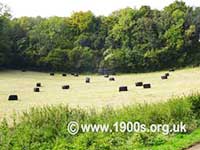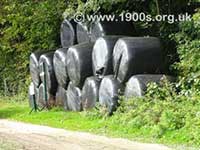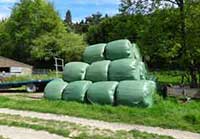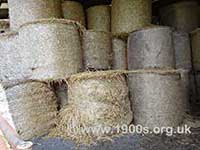How silage production changed in later years of the 20th century

How to recognise modern silage production and why it is cleaner, less smelly and more efficient than the older methods.
____
by Dick Hibberd from personal experience with photos by the webmaster. Top image produced by AI and tweaked in Photoshop.
Silage, which is fermented grass, hay and other green matter, was and still is essential for feeding cattle in the winter months when fresh grass is not available.
In the first part of the 20th century it was produced by methods that permeated the countryside in late summer with a really noxious smell. Fortunately, later in the century silage production changed with considerable benefits to efficiency while also eliminating the smell.
The new production method was stimulated by the development of polythene, and the same method is still used to day.
Signs to the traveller of modern silage production
In late summer, as you drive in the country, you will notice neatly cut fields strewn across with big black polythene parcels, something like the droppings from a ginormous deer that has relieved itself from 50 or 60 feet up. These closed packages are rolls of green matter, packed ready for fermenting into silage.

Black polythene bags of green matter/silage, lying in a field.

Black polythene bags of green matter/silage stacked ready for collection as required.

Green polythene bags of green matter/silage stacked ready for use.

Rolls of fresh, unfermented hay for immediate use.
Note from the webmaster
The farmer who owned the field with the green bages said that he chose green polythene because he thought it looked nicer and that functionally it could be any colour.
The green matter base of modern silage
The green matter, these days, is a blend of special grasses and maize. Indeed fields of maize are now grown specially for the purpose.
The grass and maize mixture is not treated with molasses as with the older method of silage production, although other nutrients may be added to encourage fermentation.
The process
The mixture of green matter is machine packed inside polythen and just left to ferment in its own juice, aided by the heat of the sun on the polythene. It is ready for use in only a few weeks.
Tractors take the polythene packages to the edge of the field and stack them.
Then, as required, the packages are taken into the cattle sheds where the wrappings are removed and the silage contents simply unrolled into a great carpet of 'delectable' food for the cows to gently munch their way through. I imagine 'bovine bliss'!
Advantages of modern silage production
contributed by a group of farmers at a country show
This type of silage production is cleaner, less smelly and more efficient than the older method.
It also has advantages over storing hay in haystacks because the grass does not have to lie in the field to dry off in the same way. Whereas the grass needed to dry to 14% or less moisture content for stacking in a haystack, the grass can have as much as 35% moisture content for this type of silage.
| sources | webmaster | contact |
Text and images are copyright
If you can add anything to this page or provide a photo, please contact me.



